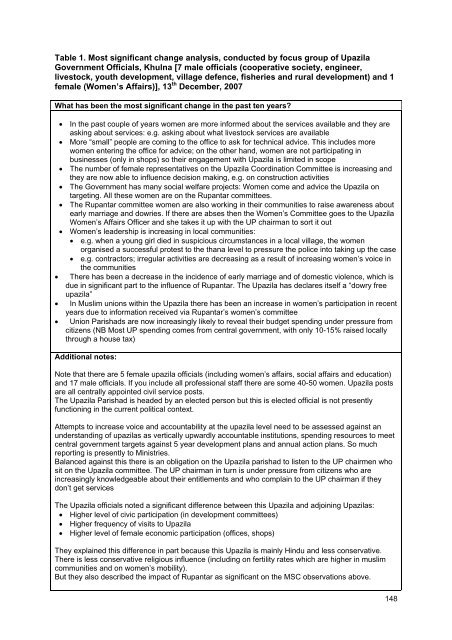Bangladesh - Belgium
Bangladesh - Belgium
Bangladesh - Belgium
You also want an ePaper? Increase the reach of your titles
YUMPU automatically turns print PDFs into web optimized ePapers that Google loves.
Table 1. Most significant change analysis, conducted by focus group of Upazila<br />
Government Officials, Khulna [7 male officials (cooperative society, engineer,<br />
livestock, youth development, village defence, fisheries and rural development) and 1<br />
female (Women’s Affairs)], 13 th December, 2007<br />
What has been the most significant change in the past ten years?<br />
• In the past couple of years women are more informed about the services available and they are<br />
asking about services: e.g. asking about what livestock services are available<br />
• More “small” people are coming to the office to ask for technical advice. This includes more<br />
women entering the office for advice; on the other hand, women are not participating in<br />
businesses (only in shops) so their engagement with Upazila is limited in scope<br />
• The number of female representatives on the Upazila Coordination Committee is increasing and<br />
they are now able to influence decision making, e.g. on construction activities<br />
• The Government has many social welfare projects: Women come and advice the Upazila on<br />
targeting. All these women are on the Rupantar committees.<br />
• The Rupantar committee women are also working in their communities to raise awareness about<br />
early marriage and dowries. If there are abses then the Women’s Committee goes to the Upazila<br />
Women’s Affairs Officer and she takes it up with the UP chairman to sort it out<br />
• Women’s leadership is increasing in local communities:<br />
• e.g. when a young girl died in suspicious circumstances in a local village, the women<br />
organised a successful protest to the thana level to pressure the police into taking up the case<br />
• e.g. contractors; irregular activities are decreasing as a result of increasing women’s voice in<br />
the communities<br />
• There has been a decrease in the incidence of early marriage and of domestic violence, which is<br />
due in significant part to the influence of Rupantar. The Upazila has declares itself a “dowry free<br />
upazila”<br />
• In Muslim unions within the Upazila there has been an increase in women’s participation in recent<br />
years due to information received via Rupantar’s women’s committee<br />
• Union Parishads are now increasingly likely to reveal their budget spending under pressure from<br />
citizens (NB Most UP spending comes from central government, with only 10-15% raised locally<br />
through a house tax)<br />
Additional notes:<br />
Note that there are 5 female upazila officials (including women’s affairs, social affairs and education)<br />
and 17 male officials. If you include all professional staff there are some 40-50 women. Upazila posts<br />
are all centrally appointed civil service posts.<br />
The Upazila Parishad is headed by an elected person but this is elected official is not presently<br />
functioning in the current political context.<br />
Attempts to increase voice and accountability at the upazila level need to be assessed against an<br />
understanding of upazilas as vertically upwardly accountable institutions, spending resources to meet<br />
central government targets against 5 year development plans and annual action plans. So much<br />
reporting is presently to Ministries.<br />
Balanced against this there is an obligation on the Upazila parishad to listen to the UP chairmen who<br />
sit on the Upazila committee. The UP chairman in turn is under pressure from citizens who are<br />
increasingly knowledgeable about their entitlements and who complain to the UP chairman if they<br />
don’t get services<br />
The Upazila officials noted a significant difference between this Upazila and adjoining Upazilas:<br />
• Higher level of civic participation (in development committees)<br />
• Higher frequency of visits to Upazila<br />
• Higher level of female economic participation (offices, shops)<br />
They explained this difference in part because this Upazila is mainly Hindu and less conservative.<br />
There is less conservative religious influence (including on fertility rates which are higher in muslim<br />
communities and on women’s mobility).<br />
But they also described the impact of Rupantar as significant on the MSC observations above.<br />
148

















